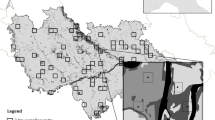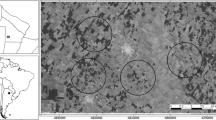Abstract
Six species of resident birds were censused in patches of deciduous forest within a coniferous forest landscape in south central Sweden. Here, the forests have been subjected to active forestry for a long time, but with recently increased intensity. Although the forest cover is more or less continuous in this landscape, mature deciduous forest is now a rare element compared with the untouched forest.
All censused patches were similar with regards to size, proportion and amount of deciduous trees, but were either isolated in the coniferous forest (‘isolated patches’) or near to other deciduous patches (‘aggregated patches’). We concentrated on six species of resident birds, with moderate area requirements, that are tied to deciduous forest and whose ecology is well-known. The Nuthatch and the Marsh tit, which both show strict year-round territoriality and have a restricted dispersal phase, were significantly more likely to be found in aggregated than in isolated patches. No effect was found for the Great tit and the Blue tit, which are less territorial outside the breeding season and have a longer dispersal phase. Moreover, the Great tit is less specialized on deciduous forest than the other species. Also, the Long-tailed tit was negatively affected by isolation, which may be due to restricted dispersal and to larger area requirements of this flock-territorial species. The Hazel grouse, finally, was not affected, but this larger bird probably uses the forest in a different way from the smaller species.
Our study clearly shows that fragmentation of one type of forest (deciduous) within another can have serious detrimental effects on forest-living species and raises important issues for forest management practices and conservation within a forest landscape.
Similar content being viewed by others
References
Ahlén, I. and Nilsson, S.O. 1982. Samband mellan fågelfauna och biotopareal på öar med naturskog i Mälaren och Hjälmaren. Vår Fågelv. 41: 161–184.
Andrén, H. 1989. Predation processes in fragmented boreal forest landscapes. Ph.D.-thesis, Uppsala Univ., Uppsala.
Angelstam, P. 1990. Factors determining the composition and persistence of local woodpecker assemblages in taiga forest in Sweden - a case for landscape ecological studies. In Conservation and management of woodpecker populations, pp. 147–164. Edited by Carlson, A. and Aulén, G. Swedish Univ. Agr. Sci., Dept. Wildl. Ecol. Uppsala, Report 17; Uppsala.
Angelstam, P. 1991. Changes in forest landscapes and bird conservation in northern Europe. Acta Congr. Int. Orn. 20: 2292–2297.
Angelstam, P. 1992. Conservation of communities - the importance of edges, surroundings and landscape mosaic structure. In Ecological principles of nature conservation, pp. 9–70. Edited by Hansson, L. Elsevier, Barking.
Angelstam, P. Ghost of forest past - natural disturbance regimes as a basis for reconstruction of biologically diverse forests in Europe. In Conservation of wildlife diversity in forested landscapes. Edited by DeGraaf, R.M. Chapman and Hall, New York: in press a.
Angelstam, P. Fire-dynamics of taiga landscapes as a model for combining forestry and biodiversity. In Fire in ecosystems of northern Eurasia. Edited by Goldammer, J. and Furyaev, V.: in press b.
Angelstam, P. and Mikusinski, G. 1994. Woodpecker assemblages in natural and managed boreal and hemiboreal forest - a review. Ann. Zool. Fennici 31: 157–172.
Askins, R.A. 1981. Survival in winter: the importance of roost holes to resident birds. Loon 53: 179–184.
Aulén, G. 1988. Ecology and distribution history of the whitebacked woodpecker Dendrocopos leucotos in Sweden. Ph.D.-thesis, Swedish Univ. Agr. Sci., Uppsala.
Berg, Å, Ehnström, B., Gustafsson, L., Hallingbäck, T., Jonsell, M. and Weslien, J. 1994. Threatened plant, animal and fungus species in Swedish forests: distribution and habitat associations. Conserv. Biol. 8: 718–731.
Blake, J.G. 1991. Nested subsets and the distribution of birds on isolated woodlots. Conserv. Biol. 5: 58–66.
Blake, J.G. and Karr, J.R. 1987. Breeding birds of isolated woodlots: area and habitat relationships. Ecology 68: 1724–1734.
Ehnström, B. and Waldén, H.W. 1986. Faunavård i skogsbruket: lägre faunan. Skogsstyrelsen, Jönköping. Enoksson, B. 1987. Local movements in the nuthatch Sitta europaea. Acta Reg. Soc. Sci. Litt. Gothoburgensis. Zoologica 14: 36–47.
Enoksson, B. 1988. Prospective resource defence and its consequences in the nuthatch Sitta europaea L., Ph.D.-thesis, Uppsala Univ., Uppsala.
Enoksson, B. 1990. Autumn territories and population regulation in the nuthatch Sitta europaea: an experimental study. J. Anim. Ecol. 59: 1047–1062.
Esseen, P-A., Ehnström, B., Ericson, L. and Sjöberg, K. 1992. Boreal forests - the focal habitats of Fennoscandia. In Ecological principles of nature conservation, pp. 252–325. Edited by Hansson, L. Elsevier, Barking.
Gaston, A.J. 1973. The ecology and behaviour of the long-tailed tit. Ibis 115: 330–351.
Glen, N.W. and Perrins, C.M. 1988. Co-operative breeding by long-tailed tits. Br. Birds 81: 630–641.
Harris, L.D. 1984. The fragmented forest. Univ. Chicago Press, Chicago.
Helle, P. and Järvinen, O. 1986. Population trends of North Finnish land birds in relation to their habitat selection and changes in forest structure. Oikos 46: 107–115.
Hunter, M. 1990. Wildlife, forests and forestry. Prentice-Hall, Englewood Cliffs, New Jersey.
Ihse, M. 1993. Naturvårdanpassad planering i skogsbruket med hjälp av flygbilder i IR-film, Skogsstyrelsen Rapport 93(1): 19–32.
Ingelög, T., Gustafson, L. and Larsson, B.M.P. 1991. Floravård i skogsbruket. Skogsstyrelsen,Jönköping.
Kendeigh, S.C. 1961. Energy of birds conserved by roosting in cavities. Wilson Bull. 73: 140–147.
Laurance, W.F. 1990. Comparative responses of five arboreal marsupials to tropical forest fragmentation. J. Mammal. 71: 641–653.
MacArthur, R.H. and Wilson, E.O. 1967. The theory of island biogeography. Princeton Univ. Press, Princeton.
Matthysen, E. 1987. Territory establishment of juvenile nuthatches after fledging. Ardea 75: 53–57.
Matthysen, E. 1988. Populatiedynamiek, sociale organisatie en habitat kwaliteit bij de boomklever Sitta europaea L. Ph.D.-thesis, Antwerpen Univ., Wilrijk.
Matthysen, E. and Schmidt, K-H. 1987. Natal dispersal in the nuthatch. Ornis Scand. 18: 313–316.
Moore, N.W. and Hooper, M.D. 1975. On the number of bird species in British woods. Biol. Conserv. 8: 239–250.
Nilsson, J-Å 1988. Causes and consequences of dispersal in marsh tits: time as a fitness factor in establishment. Ph.D.-thesis, Lund Univ., Lund.
Nilsson, J-Å and Smith, H.G. 1988. Effects of dispersal date on winter flock establishment and social dominance in marsh tits Parus palustris. J. Anim. Ecol. 57: 917–928.
Nilsson, S.G., Olsson, O., Svensson, S. and Wiktander, U. 1992. Population trends and fluctuations in Swedish woodpeckers. Ornis Svecica 2: 13–21.
Opdam, P., van Dorp, D. and ter Braak, C.J.F. 1984. The effect of isolation on the number of woodland birds in small woods in the Netherlands, J. Biogeogr. 11: 473–478.
Opdam, P., Rijsdijk, G. and Hustings, F. 1985. Bird communities in small woods in an agricultural landscape: effects of area and isolation. Biol. Conser. 34: 333–352.
Perrins, C.M. 1979. British tits. Collins, London.
Potter, M.A. 1990. Movements of North Island brown kiwi (Apteryx australis mantelli) between forest remnants. New Zeal. J. Ecol. 14: 17–24.
Saunders, D.A., Hobbs, R.J. and Margules, C.R. 1991. Biological consequences of ecosystem fragmentation: a review. Conserv. Biol. 5: 18–32.
Svensson, S. 1975. Handledning för svenska häckfågeltaxeringen. Zool. Inst., Lund.
Svensson, S.A. 1980. Riksskogstaxeringen 1973–77, skogstill-stånd, tillväxt och avverkning. Report 30. Swedish Univ. Agr. Sci., Dept. For. Surv., Umeå.
Swenson, J.E. 1991a. Evaluation of a density index for territorial male hazel grouse Bonasa bonasia in spring and autumn. Ornis Fenn. 68: 57–65.
Swenson, J.E. 1991b. Social organization of hazel grouse and ecological factors influencing it. Ph.D.-thesis, Univ. Alberta, Edmonton.
Swenson, J.E. 1991c. Is the hazel grouse a poor disperser? Trans. Int. Union Game Biol. Congr. 20: 347–352.
Swenson, J.E. and Angelstam, P. 1993. Habitat separation by sympatric forest grouse in Fennoscandia in relation to boreal forest succession. Can. J. Zool. 71: 1303–1310.
Temple, S.A. 1986. Predicting impacts of habitat fragmentation on forest birds: a comparison of two models, pp. 301–304. In Wildlife 2000: modelling habitat relationships of terrestrial vertebrates. Edited by Verner, J., Morrison, M.L. and Ralph, C.J. Univ. Wisconsin Press, Madison.
Ulfstrand, S. 1962. On the nonbreeding ecology and migratory movements of the great tit (Parus major) and the blue tit (Parus caeruleus) in southern Sweden. Vår Fågelv. Suppl. 3: 1–145.
Ulfstrand, S. 1976. Feeding niches of some passerine birds in a South Swedish coniferous plantation in winter and summer. Ornis Scand. 7: 21–27.
Väisänen, R.A., Järvinen, O. and Rauhala, P. 1986. How are extensive, human-caused habitat alterations expressed on the scale of local populations in boreal forests? Ornis Scand. 17: 282–292.
van Balen, J.H. and Hage, F. 1989. The effect of environmental factors on tit movements. Ornis Scand. 20: 99–104.
van Dorp, D. and Opdam, P.F.M. 1987. Effects of patch size, isolation and regional abundance on forest bird communities. Landscape Ecol. 1: 59–73.
van Wagner, C.E. 1978. Age-class distribution and the forest fire cycle. Can. J. For. Res. 8: 431–460.
Wilcove, D.S., McLellan, C.H. and Dobson, A.P. 1986. Habitat fragmentation in the temperate zone. In Conservation biology, pp. 237–256. Edited by Soulé, M.E. Sinauer, Sunderland.
Wilcove, D.S. and Robinson, S.K. 1990. The impact of forest fragmentation on bird communities in Eastern North America. In Biogeography and ecology of forest bird communities, pp. 319–331. Edited by Keast, A. SPB Academic Publ. The Hague.
Author information
Authors and Affiliations
Rights and permissions
About this article
Cite this article
Enoksson, B., Angelstam, P. & Larsson, K. Deciduous forest and resident birds: the problem of fragmentation within a coniferous forest landscape. Landscape Ecol 10, 267–275 (1995). https://doi.org/10.1007/BF00128994
Issue Date:
DOI: https://doi.org/10.1007/BF00128994




